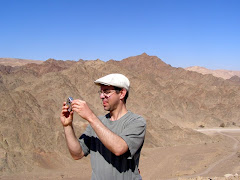

While the Parthenon didn't immediately strike an aesthetic chord in me, the idea of the statue of Athena (Athena Parthenos) by a sculptor named Phidias did. I longed to see the replica, known as the Varvakios Athena, in the National Archeological Museum of Athens. The Parthenon itself became an exercise in imagination as I tried to piece the parts of the building together. This extended to London where I saw the Elgin Marbles in the British Museum.
My level of interest in the building was high but becoming aware that it served as a Byzantine Church dedicated to Mary made it considerably more meaningful. F
 rom Istanbul, through Bulgaria, to Thessaloniki and even into Athens the theme remained the same. I was interested in Byzantium and there was no escape. I embrased my fate--aware that reality is multi-faceted and a place like Athens has a present as well as various pasts and that it can be appreciated through various lenses. The same thinking that led me to embraced Jerusalem's Mamluk era.
rom Istanbul, through Bulgaria, to Thessaloniki and even into Athens the theme remained the same. I was interested in Byzantium and there was no escape. I embrased my fate--aware that reality is multi-faceted and a place like Athens has a present as well as various pasts and that it can be appreciated through various lenses. The same thinking that led me to embraced Jerusalem's Mamluk era.There were a few of Athens' Byzantine Churches that have proven memorable. One, the Church of Kapnikarea, is in the middle of a street. When Ermou Street was being planned, the idea was to knock down the old church but preservationists fought to save it and the street was built around it. The Church of Kapnikarea shows what the impressive Byzantine Museums in both Thessaloniki and Athens tell--at least some Greek folk value their Byzantine heritage.
I found the church of the Holy Apostles in the Ancient Agora to be the most meaningful of Athens' Byzantine Churches. This church, which was built in the late 10th or early 11th century, commemorates the apostle Paul preaching in the agora to the Greeks as recorded in Acts 17: "Then Paul stood in the midst of Mars' hill, and said, Ye men of Athens, I perceive that in all things ye are too superstitious. For as I passed by, and beheld your devotions, I found an alter with the inscription, to the unknown god. Whom therefore ye ignor
 antly worship, him declare I unto you." Along with being meaningful in commemorating Paul's preaching, the church's design is attractive and it's setting is pleasing.
antly worship, him declare I unto you." Along with being meaningful in commemorating Paul's preaching, the church's design is attractive and it's setting is pleasing. 
Another memorable church is the Church of Theotokos Gorgoepikoos and Ayios Eleytherios. This church is unique in it's being constructed of marble as opposed to the typical Byzantine brick.
I spent enough time in Athens to get a taste for other periods as well but the very ancient didn't excite me much and I wasn't there long enough to absorb much of the modern--seeing the original modern Olympic stadium reminded me that the Olympics has ceased to mean much to me. The Roman period ruins were impressive--more grandiose than the real Greek stuff--but not as meaningful as the era of Plato and Sophocles.



